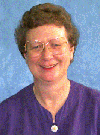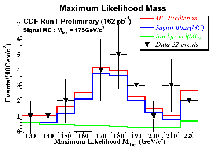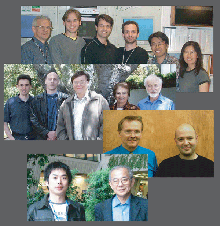 | Thursday, May 20, 2004 |
|
Thursday, May 20 THERE WILL BE NO THEORETICAL PHYSICS SEMINAR TODAY 11:45 a.m. Third Thursday Lunchtime Cleanup - WH - Ground Floor, East Side 3:30 p.m. DIRECTOR'S COFFEE BREAK - 2nd Flr X-Over THERE WILL BE NO ACCELERATOR PHYSICS AND TECHNOLOGY SEMINAR TODAY
Friday, May 21 |
|
Thursday, May 20 Southwestern Chicken Tortilla Philly Style Cheese Steak $4.75 Baked Fish with Roasted Leeks and Peppers $3.75 Tomato Basil Chicken Parmesan $3.75 Classic Cuban Panini $4.75 Cheesy Breadsticks $1.85 Marinated Grilled Chicken Caesar Salads $4.75 Wilson Hall Cafe Menu Chez Leon |
|
Extended Forecast |
Secon Level 3 |
| Fermilab Today is online at: http://www.fnal.gov/today/ Send comments and suggestions to today@fnal.gov Fermilab Today archive Fermilab Today PDF Version Fermilab Today classifieds Subscribe/Unsubscribe to |
|
Glass, Elias Host RPI Alumni Group Tour Rensselaer graduates Hank Glass ('78), of TD-Development and Test, and John Elias ('62), of PPD-CMS, hosted an April 17 lab tour for the Chicago chapter of the Rensselaer Alumni Association, escorting about two dozen
"This kind of group event was relatively easy to organize, and a lot of people were very pleased at getting a chance to see Fermilab," said Glass.
Rensselaer Polytechnic Institute, in Troy, New York is the country's
oldest technological institution, founded in 1824. Rensselaer president
Shirley Ann Jackson was an early postdoc in Fermilab's theory group,
and is now a member of the lab's Board of Trustees.
|
|
News from the Users' Executive Committee Register for the Annual Users' Meeting Now
The UEC is also in the final stages of planning the annual Users Meeting, which
will be held June 2nd and 3rd in the Wilson Auditorium. Even though
there is no fee, Users are encouraged to register online.
A complete schedule for the Users' meeting is also available online.
|
|
May 17 - May 19 - Operations established two stores during this period of time that provided the experiments with approximately 16 hours and 32 minutes of luminosity. - Colliding beam problems continued to bother the TeV - Linac had a stuck vacuum valve - C3 cold compressor tripped off and caused TeV quench
View the current accelerator update |
|
From Nature Magazine, May 19, 2004 Iranian physicist locked out of laboratory by energy department by Geoff Brumfiel His supervisor believes he will be one of the achievers of tomorrow, he has just won an award from the American Physical Society — and he has been banned from his lab for more than a year by the US Department of Energy (DOE).
Shahram Rahatlou is an Iranian high-energy physicist based at the University of California, San Diego (UCSD), whose research involves using the BaBar particle detector at the Stanford Linear Accelerator Center (SLAC). But since February last year, he has been prohibited from entering the grounds of SLAC, where he has worked for the past six years.
|
|
From Nature Magazine, Editorial, May 19, 2004 Equal treatment under the law If this fundamental right is denied to visiting researchers, the quality of US science will suffer. Since February 2003, Iranian physicist Shahram Rahatlou has been barred from entering the government lab where he worked. The security officials who came to his door never told him what he had done wrong. They said there would be no appeal.
The lab is not in Iran, but at the Stanford Linear Accelerator Center (SLAC) in California. Rahatlou had been working there for nearly five years when officers from the US Department of Energy (DOE) visited him. He had, by all accounts, been an exceptional physicist. SLAC is a purely academic laboratory, which houses no classified research, and the experiment on which he was working makes all its findings publicly available. Even the lab's scientific leaders don't know why Rahatlou was barred from the premises (see page 229).
|
|
CDF Takes Three Paths to the Top Mass |
|
The top quark, the most massive known elementary particle, was
first observed in 1994 at the Tevatron. Its mass can be used to
predict that of the Higgs particle--a crucial, but still undiscovered,
elementary particle in the Standard Model of Particle Physics.
Three teams at CDF have recently completed measurements of the top-quark mass using Tevatron Run II top/anti-top pair events. In the decay mode studied, one top quark decays to a charged lepton, a neutrino, and a bottom quark, while the other decays to three quarks, one of which is a bottom quark. At least one of the bottom quarks is identified by the silicon detector. |
|
The Dynamical Likelihood Method, originally proposed by Kunitaka Kondo in 1988, discriminates among possible top-mass values using observables of the top-quark decay products. It uses the maximum amount of information on top quarks provided by the Standard Model. Two independent methods, based on different assumptions, produce similar results. The Template Method reconstructs the invariant mass of the top quark in each event, while the Multivariate Template Method enhances this approach by adding information on quark-jet energy and event topology.
The Dynamical Likelihood Method yields a top mass: Through these measurements, CDF has established techniques that will provide precise determination of the top-quark mass as Run II continues. |
|
Result of the Week Archive |
|
Third Thursday Lunchtime Cleanup Today There will be a Lunchtime Cleanup from 11:45 a.m. to 1:30 p.m. today. Meet at the East Ground Floor entrance to Wilson Hall for transportation to the cleanup site. Cleaning gear is provided, and hot dogs and refreshments will be served. Contact Bob Lootens at x3303 for more information. more information
NIU Scicamp
Fermilab Picnic and Cougar Game |




